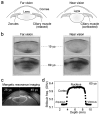Translating ocular biomechanics into clinical practice: current state and future prospects
- PMID: 24832392
- PMCID: PMC4233020
- DOI: 10.3109/02713683.2014.914543
Translating ocular biomechanics into clinical practice: current state and future prospects
Abstract
Biomechanics is the study of the relationship between forces and function in living organisms and is thought to play a critical role in a significant number of ophthalmic disorders. This is not surprising, as the eye is a pressure vessel that requires a delicate balance of forces to maintain its homeostasis. Over the past few decades, basic science research in ophthalmology mostly confirmed that ocular biomechanics could explain in part the mechanisms involved in almost all major ophthalmic disorders such as optic nerve head neuropathies, angle closure, ametropia, presbyopia, cataract, corneal pathologies, retinal detachment and macular degeneration. Translational biomechanics in ophthalmology, however, is still in its infancy. It is believed that its use could make significant advances in diagnosis and treatment. Several translational biomechanics strategies are already emerging, such as corneal stiffening for the treatment of keratoconus, and more are likely to follow. This review aims to cultivate the idea that biomechanics plays a major role in ophthalmology and that the clinical translation, lead by collaborative teams of clinicians and biomedical engineers, will benefit our patients. Specifically, recent advances and future prospects in corneal, iris, trabecular meshwork, crystalline lens, scleral and lamina cribrosa biomechanics are discussed.
Keywords: Brillouin microscopy; intraocular pressure; ocular biomechanics; ophthalmic pathologies; optical coherence tomography; personalised medicine; translational biomechanics.
Figures





Similar articles
-
Altering the way the optic nerve head responds to intraocular pressure-a potential approach to glaucoma therapy.Curr Opin Pharmacol. 2013 Feb;13(1):83-9. doi: 10.1016/j.coph.2012.09.001. Epub 2012 Sep 19. Curr Opin Pharmacol. 2013. PMID: 22999652 Review.
-
Glaucoma and biomechanics.Curr Opin Ophthalmol. 2022 Mar 1;33(2):80-90. doi: 10.1097/ICU.0000000000000829. Curr Opin Ophthalmol. 2022. PMID: 34954731 Free PMC article. Review.
-
Modeling individual-specific human optic nerve head biomechanics. Part I: IOP-induced deformations and influence of geometry.Biomech Model Mechanobiol. 2009 Apr;8(2):85-98. doi: 10.1007/s10237-008-0120-7. Epub 2008 Feb 29. Biomech Model Mechanobiol. 2009. PMID: 18309526
-
A porohyperelastic finite element model of the eye: the influence of stiffness and permeability on intraocular pressure and optic nerve head biomechanics.Comput Methods Biomech Biomed Engin. 2016;19(6):591-602. doi: 10.1080/10255842.2015.1052417. Epub 2015 Jul 21. Comput Methods Biomech Biomed Engin. 2016. PMID: 26195024 Free PMC article.
-
Factors influencing optic nerve head biomechanics.Invest Ophthalmol Vis Sci. 2005 Nov;46(11):4189-99. doi: 10.1167/iovs.05-0541. Invest Ophthalmol Vis Sci. 2005. PMID: 16249498
Cited by
-
Brillouin microscopy: assessing ocular tissue biomechanics.Curr Opin Ophthalmol. 2018 Jul;29(4):299-305. doi: 10.1097/ICU.0000000000000489. Curr Opin Ophthalmol. 2018. PMID: 29771749 Free PMC article. Review.
-
Pulsatile tissue deformation dynamics of the murine retina and choroid mapped by 4D optical coherence tomography.Biomed Opt Express. 2022 Jan 7;13(2):647-661. doi: 10.1364/BOE.445093. eCollection 2022 Feb 1. Biomed Opt Express. 2022. PMID: 35284183 Free PMC article.
-
Anterior pituitary, sex hormones, and keratoconus: Beyond traditional targets.Prog Retin Eye Res. 2022 May;88:101016. doi: 10.1016/j.preteyeres.2021.101016. Epub 2021 Nov 2. Prog Retin Eye Res. 2022. PMID: 34740824 Free PMC article.
-
Optical coherence elastography - OCT at work in tissue biomechanics [Invited].Biomed Opt Express. 2017 Jan 27;8(2):1172-1202. doi: 10.1364/BOE.8.001172. eCollection 2017 Feb 1. Biomed Opt Express. 2017. PMID: 28271011 Free PMC article. Review.
-
Biomechanical contribution of the sclera to dynamic corneal response in air-puff induced deformation in human donor eyes.Exp Eye Res. 2020 Feb;191:107904. doi: 10.1016/j.exer.2019.107904. Epub 2019 Dec 25. Exp Eye Res. 2020. PMID: 31883460 Free PMC article.
References
-
- Fung YC. Biomechanics: Mechanical properties of living tissues. 2nd. New York, NY: Springer-Verlag; 1993.
-
- McBrien NA, Jobling AI, Gentle A. Biomechanics of the sclera in myopia: extracellular and cellular factors. Optom Vis Sci. 2009;86(1):E23–30. - PubMed
-
- Sigal IA, Roberts MD, Girard MJA, Burgoyne CF, Downs JC. Ocular disease: mechanisms and management. New York: Elvesier; 2009. Biomechanical changes of the optic disc.
-
- Camras LJ, Stamer WD, Epstein D, Gonzalez P, Yuan F. Differential effects of trabecular meshwork stiffness on outflow facility in normal human and porcine eyes. Invest Ophthalmol Vis Sci. 2012;53(9):5242–50. Epub 2012/07/13. - PubMed
Publication types
MeSH terms
Grants and funding
- K25 EB015885/EB/NIBIB NIH HHS/United States
- R01 EY023966/EY/NEI NIH HHS/United States
- R01 EY023381/EY/NEI NIH HHS/United States
- P30-EY008098/EY/NEI NIH HHS/United States
- P41-EB015903/EB/NIBIB NIH HHS/United States
- P30 EY008098/EY/NEI NIH HHS/United States
- R01 EY002120/EY/NEI NIH HHS/United States
- R21 EY023043/EY/NEI NIH HHS/United States
- R21EY023043/EY/NEI NIH HHS/United States
- UL1-RR025758/RR/NCRR NIH HHS/United States
- R01-EY023966/EY/NEI NIH HHS/United States
- P41 EB015903/EB/NIBIB NIH HHS/United States
- K25EB015885/EB/NIBIB NIH HHS/United States
- UL1 RR025758/RR/NCRR NIH HHS/United States
LinkOut - more resources
Full Text Sources
Other Literature Sources
Medical
Miscellaneous
